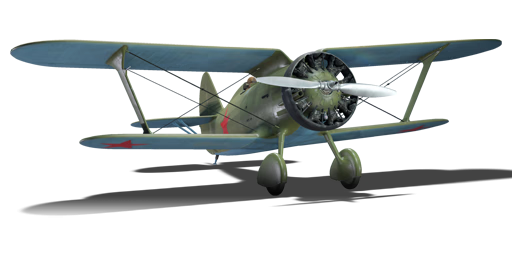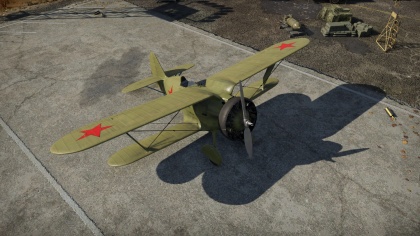I-15 WR
Contents
| This page is about the Russian biplane I-15 WR. For other uses, see I-15 (Family). |
Description
The I-15 WR is a rank I Russian fighter
with a battle rating of 1.0 (AB/RB/SB). It has been in the game since the start of the Open Beta Test prior to Update 1.27.
The I-15 WR is a single-engine fighter developed by the OKB Polikarpov as the I-15 (TsKB-3), first released in 1934 which featured a biplane mixed design with a gull-type upper wing, open cockpit and non-retractable landing gear. The I-15 WR fighter was developed at the Central Design Bureau under the direction of N. N. Polikarpov. This aircraft was a further development and refinement of the existing I-5 and I-6 fighters. The main task of the designers when creating the I-15 WR was to improve aerodynamics without significant changes to the overall size of the aircraft. The first prototype first flew in October 1934 under the direction of test pilot V. P. Chkalov. This aircraft had an American 9-cylinder star-shaped, air-cooled engine Wright Cyclone SGR-1820-F-3 installed which had a take-off capacity of 715 litres.
Preparations for mass production of the I-15 began even before the completion of flight tests. The first serial fighter of its type, the I-15, was built at aircraft factory No. 39 the summer of 1934. The initial armament of this fighter series consisted of two 7.62 mm synchronized PV-1 machine guns (“Aircraft machine gun” - a version of Maxim machine gun designed for installation on aeroplanes) with 750 rounds of ammunition per barrel. Cartridges loaded into ammunition belts and were housed in the central part of the fuselage just behind the gas tank. Provisions were made to also collect the spent ammunition casings. Aiming the machine guns was carried out using an optical sight OP-1 (a variant of the British "Aldis"), which was placed on the edge of the pilot's visor. In the event the optical sight failed, a backup mechanical ring sight, the KP-5 was attached to the telescopic sight tube.
Under the lower wing, four Der-32 bomb racks could be installed for small-calibre bombs with a total mass of up to 40 kg (4 x P-7, or 4 x AO-8, or 4 x AO-10), however, two 50 kg FAB-50 bombs could be taken as maximum payload as is the option here in War Thunder. Total aircraft production in 1934, between the two Moscow Aviation Manufacturing Plants, No. 1 and No. 39 produced 94 I-15 fighters. The first batch of 50 aircraft featured the American SGR-1820-F-3 engines installed as manufactured, however, after April 1934 the rest of the Wright Cyclone engines underwent alterations and improvements at the request of Soviet engineers in which particular changes were made especially to the machine gun synchronization mechanism installed on the engine.
General info
Flight Performance
Describe how the aircraft behaves in the air. Speed, manoeuvrability, acceleration and allowable loads - these are the most important characteristics of the vehicle.
| Characteristics | |||||||
|---|---|---|---|---|---|---|---|
| Stock | |||||||
| Max Speed (km/h at 3,000 m) |
Max altitude (meters) |
Turn time (seconds) |
Rate of climb (meters/second) |
Take-off run (meters) | |||
| AB | RB | AB | RB | AB | RB | ||
| 358 | 348 | 9200 | 8.1 | 8.7 | 10.5 | 10.5 | 125 |
| Upgraded | |||||||
| Max Speed (km/h at 3,000 m) |
Max altitude (meters) |
Turn time (seconds) |
Rate of climb (meters/second) |
Take-off run (meters) | |||
| AB | RB | AB | RB | AB | RB | ||
| 379 | 368 | 9200 | 7.9 | 8.0 | 16.9 | 13.4 | 125 |
Details
| Features | ||||
|---|---|---|---|---|
| Combat flaps | Take-off flaps | Landing flaps | Air brakes | Arrestor gear |
| ✓ | X | X | X | X |
| Limits | ||||
|---|---|---|---|---|
| Wing-break speed (km/h) |
Gear limit (km/h) |
Combat flaps (km/h) |
Max Static G | |
| + | - | |||
| 520 | ~11 | ~4 | ||
| Optimal velocities | |||
|---|---|---|---|
| Ailerons (km/h) |
Rudder (km/h) |
Elevators (km/h) |
Radiator (km/h) |
| < 180 | < 360 | < 260 | > 180 |
| Compressor (RB/SB) | ||
|---|---|---|
| Setting 1 | ||
| Optimal altitude | 100% Engine power | WEP Engine power |
| 1,000 m | 570 hp | N/A |
Survivability and armour
Examine the survivability of the aircraft. Note how vulnerable the structure is and how secure the pilot is, whether the fuel tanks are armoured, etc. Describe the armour, if there is any, and also mention the vulnerability of other critical aircraft systems.
Armaments
Offensive armament
The I-15 WR is armed with:
- 4 x 7.62 mm PV-1 machine guns, nose-mounted (750 rpg = 3,000 total)
Suspended armament
The I-15 WR can be outfitted with the following ordnance:
- Without load
- 2 x 50 kg FAB-50 bombs (100 kg total)
Usage in battles
Describe the tactics of playing in an aircraft, the features of using vehicles in a team and advice on tactics. Refrain from creating a "guide" - do not impose a single point of view, but instead, give the reader food for thought. Examine the most dangerous enemies and give recommendations on fighting them. If necessary, note the specifics of the game in different modes (AB, RB, SB).
Manual Engine Control
| MEC elements | ||||||
|---|---|---|---|---|---|---|
| Mixer | Pitch | Radiator | Supercharger | Turbocharger | ||
| Oil | Water | Type | ||||
| Controllable | Not controllable Not auto controlled |
Not controllable Not auto controlled |
Controllable Not auto controlled |
Separate | Not controllable 1 gear |
Not controllable |
Modules
| Tier | Flight performance | Survivability | Weaponry | |
|---|---|---|---|---|
| I | Fuselage repair | Radiator | Offensive 7 mm | |
| II | Compressor | New 7 mm MGs | ||
| III | Wings repair | Engine | Airframe | DZ-40 |
| IV | Cover | |||
Pros and cons
Pros:
- Insane turn time of 8 seconds
- Four 7.62 mm machine guns are powerful for its rating
- Small target overall
Cons:
- First-Person zoom view can be obstructed by the telescope
- Vulnerable to heavy machine gun fire (ex. .50 calibre M2 Browning, 12.7 mm Breda SAFAT)
- Bomb load is not very good for attacking ground targets
- Rather slow in general compared to other aircraft at its rank
History
Describe the history of the creation and combat usage of the aircraft in more detail than in the introduction. If the historical reference turns out to be too long, take it to a separate article, taking a link to the article about the vehicle and adding a block "/ History" (example: https://wiki.warthunder.com/(Vehicle-name)/History) and add a link to it here using the main template. Be sure to reference text and sources by using <ref></ref>, as well as adding them at the end of the article with <references />. This section may also include the vehicle's dev blog entry (if applicable) and the in-game encyclopedia description (under === Encyclopedia Info ===, also if applicable).
Media
Excellent additions to the article would be video guides, screenshots from the game, and photos.
See also
Links to the articles on the War Thunder Wiki that you think will be useful for the reader, for example:
- reference to the series of the aircraft;
- links to approximate analogues of other nations and research trees.
External links
Paste links to sources and external resources, such as:
- topic on the official game forum;
- encyclopedia page on the aircraft;
- other literature.
| USSR fighters | |
|---|---|
| I-15 | I-15 WR · I-15 M-22 · I-15 M-25 · I-15bis · Krasnolutsky's I-15bis |
| I-153 M-62 · Zhukovsky's I-153-M62 · I-153P | |
| I-16 | I-16 type 5 · I-16 type 10 · I-16 type 18 · I-16 type 24 · I-16 type 27 · I-16 type 28 · I-180S |
| I-29 | I-29 |
| I-185 | I-185 (M-71) · I-185 (M-82) |
| I-225 | I-225 |
| ITP | ITP (M-1) |
| MiG-3 | MiG-3-15 · MiG-3-15 (BK) · MiG-3-34 |
| LaGG | I-301 · LaGG-3-4 · LaGG-3-8 · LaGG-3-11 · LaGG-3-23 · LaGG-3-34 · LaGG-3-35 · LaGG-3-66 |
| La | La-5 · La-5F · La-5FN · La-7 · Dolgushin's La-7 · La-7B-20 · La-9 · La-11 |
| Yak-1/7 | Yak-1 · Yak-1B · Yak-7B |
| Yak-3 | Yak-3 · Eremin's Yak-3(e) · Yak-3P · Yak-3T · Yak-3U · Yak-3 (VK-107) |
| Yak-9 | Yak-9 · Yak-9B · Golovachev's Yak-9M · Yak-9T · Yak-9K · Yak-9U · Yak-9UT · Yak-9P |
| Other countries | ▂P-40E-1 · ▂P-47D-27 · ▂Hurricane Mk IIB · ▂Fw 190 D-9 · ▂Spitfire Mk IXc |
| P-39 | ▂P-39K-1 · ▂Pokryshkin's P-39N-0 · ▂P-39Q-15 |
| P-63 | ▂P-63A-5 · ▂P-63A-10 · ▂P-63C-5 |





